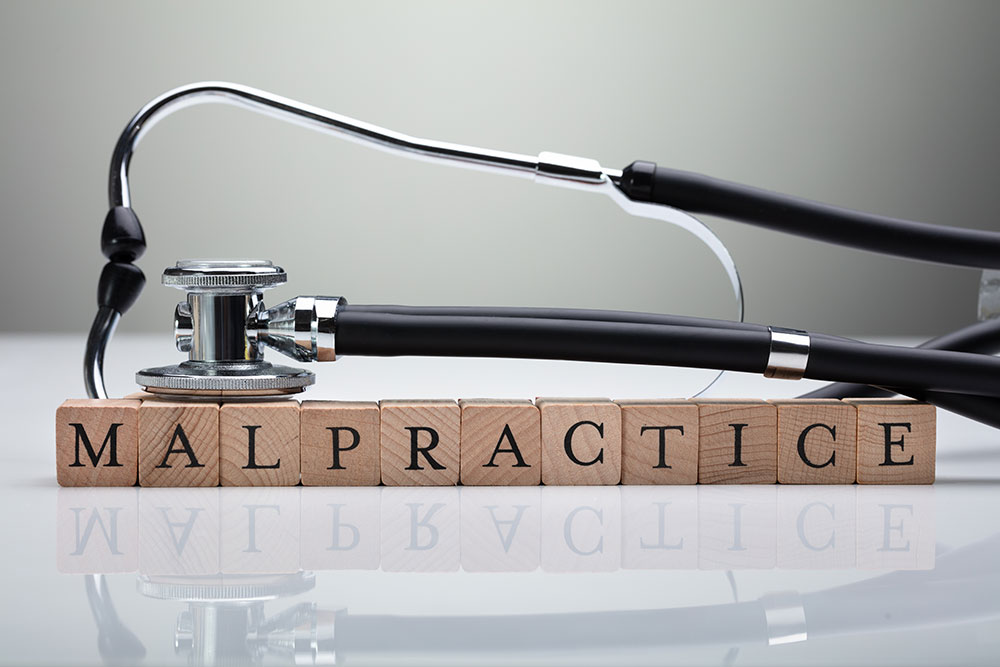If you work in the medical field, there is a chance that you may make a few mistakes during your career. Even the best trained and highly regarded medical professionals make errors, occasionally.
When a mistake occurs, you will need your medical malpractice insurance. For this reason, planning ahead and having a policy up and providing cover before you need it is the best way to protect yourself.
Many professionals in the health care industry find the world of medical insurance confusing and sometimes a bit daunting. Mixing of specific terms is easy to do as the definitions are quite similar and nuanced meanings are difficult to separate from one another. This guide will explain the often confusing world of medical malpractice insurance.
What is Medical Malpractice?
Medical professionals whose actions depart from the standards of care in their profession are committing acts of malpractice. Courts may award damages if the deeds cause injury or harm to a patient, their minor child or elder in their care.
Can a Medical Facility Be Held Liable for the Actions of the Health Care Professionals It Employs?
A medical centre is responsible for the actions of health care workers it employs. Additionally, it is responsible for the care provided by contract workers, those who work per diem, or locum physicians. It is common to name an individual and the medical establishment where they practice as codefendants in malpractice suits. Medical facilities often require practitioners to carry medical malpractice insurance in addition to personal medical indemnity.
Is Medical Indemnity Insurance the Same as Medical Malpractice Insurance?
The terms medical indemnity insurance and medical malpractice insurance are not interchangeable. However, the terms are similar and frequently confused.
Medical indemnity insurance is a type of professional indemnity cover. In Australia, the law mandates that health care professionals carry a medical indemnity policy. The policy also must cover an individual’s practice. A medical indemnity policy will protect you as well as your patients if a problem or mishap occurs. Insurers refer to medical indemnity insurance as ‘long-tail’ cover because a number of years may pass between the time when you had the cover and the settling of the claim.
What Does a Medical Indemnity Insurance Policy Cover?
Your medical indemnity policy covers you for the amount of compensation awarded to the plaintiff as well as the legal costs you incur. Your hospital training and any mistakes you may make also fall under your medical indemnity cover.
You should be aware that although the Australian government regulates medical indemnity insurance, not all policies offer identical protection. Two specific areas where medical indemnity policies differ in what they will cover are:
- CIVIL CLAIMS – Claims made because of medical negligence
- NON-CIVIL CLAIMS – Policies may vary regarding the limits and procedures associated with non-civil claims.
Some examples of non-civil claims include
- Investigations by a coroner in relation to a case that involves you
- Employment disputes
- Disciplinary investigations
- Professional investigations
- Other demands that are outside the typical requests of compensation
Some policies have specific sub-limits when it comes to non-civil claims. These limitations may apply to the following scenarios:
- Medicare audits
- Reputation management if claims against you damage your standing within the medical community
- Defamation claims, both defending and pursuing the claims
- Tax audits
- Statutory penalties such as privacy breaches or improper care of records
- Compensation for income lost due to a required appearance in court
Where Are Medical Malpractice Claims Filed?
Persons seeking damages related to medical malpractice will file claims in a civil court. Generally, the purpose of these claims is to receive monetary compensation for the plaintiff. In the case of a minor or an elder under your supervision, payment is for the child or senior adult the plaintiff represents.
What is Medical Negligence?
According to Australian law, any healthcare worker who delivers care to a patient that is not up to the reasonable and accepted standard is guilty of medical negligence.
Is Medical Negligence Limited to Doctors?
Several other members of the health care profession are liable for complaints of medical negligence. This includes:
- Dentists
- Health care specialists
- Hospital staff
- Midwives
- Nurses
- Obstetricians
- Paramedics and other emergency medical workers
- Pharmacists
- Physiotherapists
- Psychiatrists and psychologists
- Surgeons
Persons employed in these professions receive the trust of those in their care. They must work according to the principle known as the duty of care. The patients depend on their health care providers, to deliver proper care in a way that does not cause injury or in a substandard fashion. A failure to meet these standards of care and any resulting damages are against Australian statutes.
What Actions Can Constitute Medical Negligence?
Medical negligence can take many forms. These include:
- A medical worker takes no action or delays action resulting in harm to a patient under their care
- Actions taken by a health care worker are inappropriate and cause harm
- Incorrect diagnosis of or failure to diagnose a condition that any reasonable physician or medical professional would find and identify
- Actions that are taken by a health care professional resulting in harm either immediately or in the future
- Prescribing incorrect medication or medications prescribed in non-therapeutic amounts resulting in harm or a lack of impact on a patient’s condition.
- Inappropriate surgical or post-operative procedures
- Failure of a medical product that causes physical or emotional harm
What is Duty of Care?
Australian health care workers are bound by the duty of care principle. This means that in the event of an injury or other type of harm; medical negligence is not a foregone conclusion. Prior to ruling a medical worker negligent, other medical professional will examine the patient’s diagnosis, treatment plan, prognosis, and other mitigating factors. If the defendant’s actions are within the limits of what experts see as customary and appropriate care, there is no case for medical negligence because the medical worker met the standard of the duty of care.
Examples:
- Scenario one: If a patient’s abdominal incision opens after a fall, the surgeon who closed the wound is not guilty of medical negligence because the open incision is related to the fall.
- Scenario two: If a patient’s abdominal incision opens while they are watching television, there is reason to believe that the wound closure was improper or substandard. In this instance, the surgeon could be liable in a medical negligence case because the standard expected by the duty of care was unmet.
What Are Some Reasons Patients File Medical Malpractice Claims?
There are numerous reasons a patient may lodge a medical malpractice claim. Some of the most typical reasons include:
- Failure to Diagnose an Illness or Condition
- Failure to Prescribe the Appropriate Medication
- Negligent or Preventable Surgical Errors
- Mistakes During Childbirth or Erroneous Obstetric Care
- Not Conforming to Statutes Governing Patient Confidentially
- Failure to Adhere to Informed Consent Laws Where Applicable
How Do I Protect Myself During a Negligence or Malpractice Suit?
It is important to remember that your malpractice insurance cover is in place to assist you should a suit be brought against you. A few other important points to keep in mind include:
- Surprisingly, few medical negligence suits will go to trial. The preferred method of sorting out these claims is through mediation. The hope of negotiation is that both parties will reach an agreeable solution outside of court.
- Whether the claim against you goes to court or is in mediation, the burden of proof is on the plaintiff.
Will a Settlement in a Medical Malpractice Claim Against Me Arrive Quickly?
Generally, malpractice and negligence claims can take many months or even years due to the complex nature of the subject matter. Establishing many factors in the case is time-consuming and can be challenging under the best circumstances.
What Elements of a Malpractice Suit Need to Be Proven Under Australian Law?
In order for a malpractice or negligence suit to have a favourable outcome for the plaintiff, representatives must prove four components were present.
- Duty – Your obligation or duty to a patient must be evident and apparent. A vaguely implied idea of obligation or responsibility is not sufficient proof of its existence.
- Breach – After establishing duty to a patient, your breach of this obligation needs to be clear. Actions such as pulling the wrong tooth during a dental extraction or leaving a surgical sponge in a patient after surgery are examples of breach of duty.
- Causation – A link between the breach of obligation and the resulting harm is necessary. If a surgical incision becomes infected because the wound does not receive adequate care and cleaning, there is a link between a breach in duty and the condition. However, there is no evidence of causation if a patient breaks a leg after surgery because of improper crutch use.
- Damages – The damages requested by the plaintiff must be directly related to the injury or impairment the patient is experiencing. If a patient experiences occasional discomfort after physiotherapy, asking for hundreds of thousands of dollars is not proportionally reasonable. However, damages in excess of millions of dollars are likely to be appropriate if you amputate the wrong foot during a surgical procedure.
In addition to these four factors, a plaintiff in a medical negligence or malpractice suit must produce expert testimony. In order to classify an authentication of facts an expert testimony, several criteria must exist:
- The testimony comes from a professional in the same area of practice as the defendant. For example, a general surgical practitioner’s account of events would not be corroborated or disproved by a psychologist.
- The plaintiff must establish that a similar professional in a similar circumstance would act differently or recommend a different treatment than the defendant.
- The professional must measure the defendant’s actions by the accepted protocol or standard of care.
How Are Damages Awarded?
There are three specific factors that determine the amount awarded to the plaintiff.
- General Damages – These are reparations most people consider when thinking about the reasons a plaintiff receives a payout. Some examples of general damages include:
- Physical pain
- Emotional pain
- Suffering
- Special Damages – Special damages refer to the costs related to the incident. For example:
- Ongoing physiotherapy
- Domestic help
- Recurring medical procedures
- Punitive Damages – In extreme cases of negligence or malpractice, the plaintiff receives punitive damages. These cases include procedures causing death or extreme life-altering circumstances. Causing a patient’s death, loss of sight, or loss of mobility are all actions worthy of punitive damages.
What Damages Do Patients Seek in Medical Malpractice or Negligence Claims?
Normally, a plaintiff is seeking reparations in order to compensate for one or more of the following:
- Pain and suffering
- The costs of specialised care including therapists, domestic help, and home health care workers
- Wages lost because of the medical incident that led to the claim. Specifically, during the time spent recovering from the occurrence and the amount of time needed for treatment of the plaintiff’s injury
- Future income lost (also called future economic loss) because the plaintiff no longer possesses the physical or mental capacity to perform tasks necessary to maintain employment and level on income.
- The expenses involved with medical care needed to repair or reverse the condition
You likely began working in the medical field because you have a desire to help others. Although you strive to do no harm, everyone makes a mistake occasionally. However, the right insurance cover will work with you to overcome errors and help the patient who received the flawed care.
Your reputation and your practice are on the line. Do not settle for a random insurance policy. Consult with an insurance expert who can listen to the details of your work and assist you in finding the cover that meets your needs.








